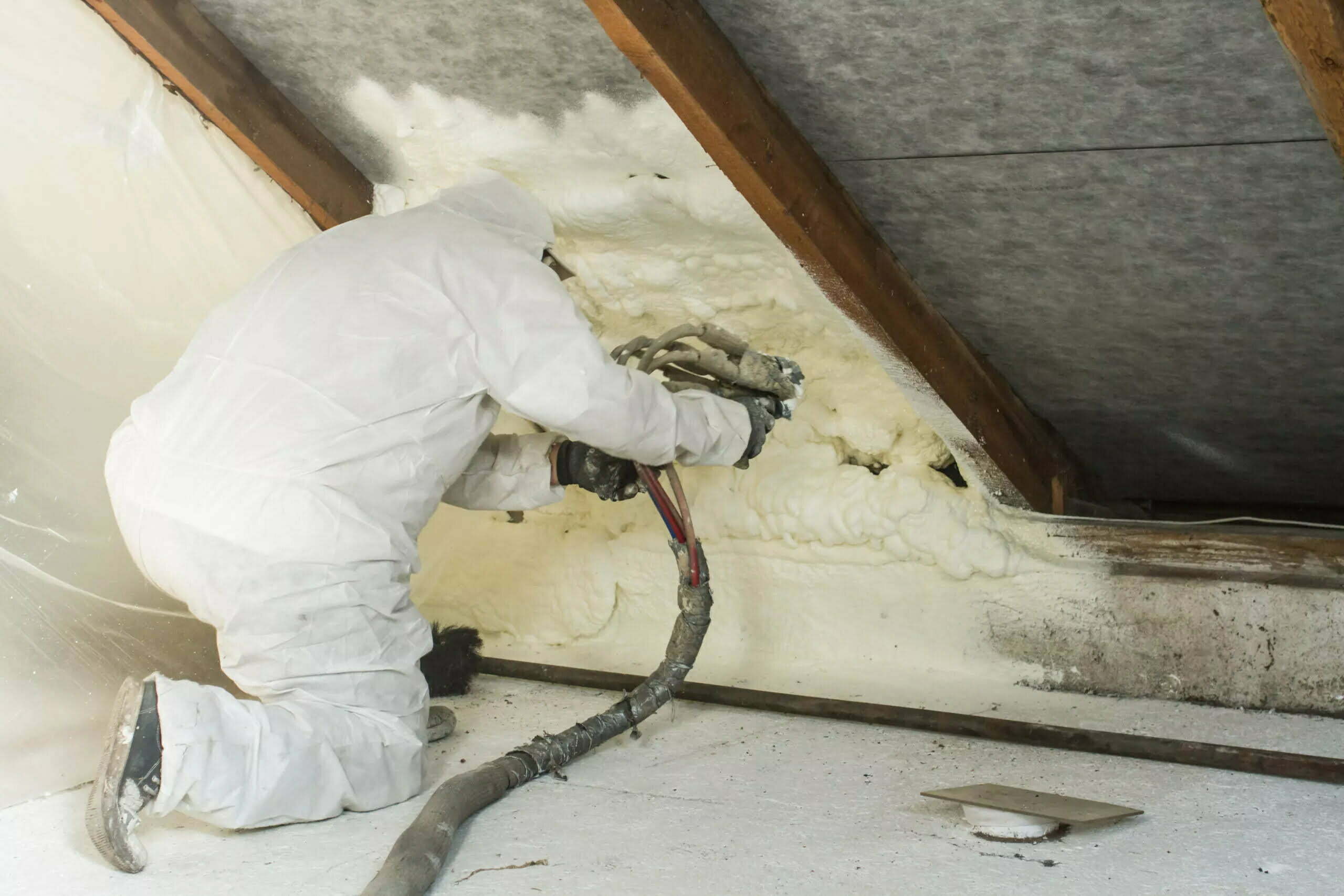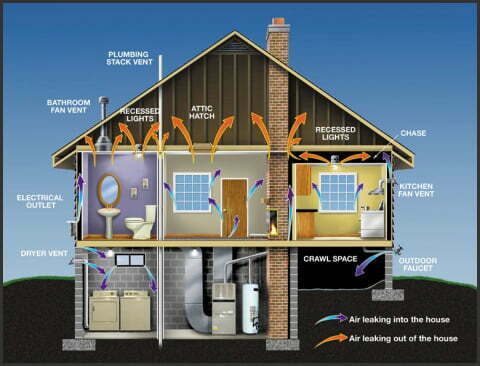When considering renovations for your home that improve energy efficiency, noise control, or the comfort of living, attic insulation might make the list. With lots of diverse insulating choices available, spray foam has become a popular choice for homeowners from coast to coast. Spray foam delivers superior insulation but costs more upfront than alternatives like fiberglass.
So, is spray foam insulation in the attic worth it? Let’s take a closer look at the advantages, costs, and alternatives to help you decide if spray foam attic insulation is the right choice for your home.
Understanding Spray Foam Insulation
First, let’s review what exactly spray foam insulation is and how it works:
What is Spray Foam Insulation?
Spray foam insulation is a type of insulation that’s sprayed into place and expands to fill any given space, thus providing the highest degree of insulation possible. It’s a two-part liquid chemical compound that expands and hardens when sprayed onto surfaces, forming a solid plastic-like material. The cured foam adheres seamlessly to surfaces. It has an impressive ability to minimize air leakage and prevent thermal bridging, making it an attractive solution for homeowners experiencing high energy bills due to poor insulation.
How Does Spray Foam Insulation Work?
The spray foam installation process involves hiring a qualified insulation specialist to come to your home. Using a spray foam gun, the contractor sprays the foam into desired areas, such as cavities in the wall, attic space, or crawl spaces. As it cures, spray foam expands up to 100 times its initial volume. This expansion process fills cracks, crevices, and gaps. The airtight seal insulates and sound deadens while blocking moisture and air infiltration.
Here is an expanded version of the sections:
The Costs Involved in Spray Foam Insulation
Spray foam insulation provides excellent insulation and air sealing but does usually come with a higher upfront cost compared to other types of insulation. Understanding the key factors that drive the pricing can help homeowners determine if spray foam insulation is the best option for their home.
Initial Costs of Spray Foam Insulation
The primary cost drivers are the extent of coverage needed, the thickness of the foam layer, the cost of labor, and the type of spray foam used.
Accurate estimates can be provided by an experienced insulation contractor after evaluating your home. Online insulation calculators can also provide ballpark figures. Keep in mind that extra costs may apply for hard-to-reach areas or special preparation work needed.
Maintenance and Long-term Costs
Properly installed spray foam insulation requires virtually no maintenance over its lifetime, which can be over 50 years. It will not settle, compress, or degrade over time like some other insulation materials.
The biggest advantage of spray foam comes from its air-sealing abilities and high R-value per inch. This allows it to provide excellent thermal performance and reductions in air leakage. Homeowners can see heating and cooling cost savings of up to 50% compared to an uninsulated home.
The upfront cost of spray foam insulation can be higher than other types of insulation. However, the energy savings usually offset the initial investment within 5-10 years. Most homeowners see a positive return on their investment in spray foam insulation through lower utility bills.
There are often rebates, tax credits, and incentives available for spray foam insulation and air sealing. Homeowners should check with their state and utility providers to see what programs are available in their area to help reduce the payback period.
Factors Affecting Cost
Several key factors determine the final cost of spray foam insulation installation. These include:
- Location: Labor and material prices can vary significantly by region. Urban areas with a higher cost of living typically have higher rates. Rural areas may have fewer contractor options and higher travel fees.
- House Size and Insulation Needs: The more square footage needing insulation coverage, the higher the overall project cost. Custom homes requiring thick insulation for maximum energy efficiency will cost more.
- New Build vs Retrofit: Insulating a new build is generally simplest with open wall cavities. Retrofits may require extra preparation, like removing old insulation or working around existing wires. This extra labor increases costs.
- Complexity: Insulating difficult areas like crawl spaces, rounded walls, and attics with obstructions can boost costs due to extra labor and materials. Contractors may apply complexity surcharges.
- Contractor Rates: More experienced insulation contractors with higher demand tend to charge premium rates. Less seasoned contractors may offer discounts to build their customer base but may not deliver the most professional results.
Evaluating the Benefits of Spray Foam Insulation in the Attic
So, is spray foam insulation in the attic worth it? The quick and short answer is an overwhelming yes! The benefits of spray foam insulation will surpass its costs. Let’s review the benefits:
Energy Efficiency and Savings
Spray foam seals attics up to 50 times tighter than other insulation, preventing costly air leaks. This results in substantial energy savings.
Sound Proofing and Comfort
The airtight, dense foam structure also dampens exterior noise and creates a quieter interior living space below the attic.
Durability and Longevity
Cured spray foam resists mold, mildew, rotting, and water damage. It outlasts other types of insulation over decades. No need to replace it!
Comparing Spray Foam Insulation with Other Insulation Types
Spray foam insulation is a renowned option when it comes to the struggle against high energy bills, poor insulation, and air leakage in your existing home. But how does spray foam rate compare to fiberglass, cellulose, or mineral wool insulation?
Fiberglass Insulation vs Spray Foam
Fiberglass insulation can be a perfectly appropriate option for many homes. But one of the biggest advantages of using spray foam is that it effectively creates an even air seal. The result is superior energy efficiency, a decrease in energy bills, and improved indoor air quality. Thus, the initial high spray foam insulation cost often translates into long-term cost savings and increases in home comfort.
Consult your home inspection team or a professional contractor to weigh the benefits of both options against limitations like crawl spaces, rim joists, or a vented system in your home.
Cellulose Insulation vs Spray Foam
Spray foam provides an exceptional barrier against air infiltration and manages moisture levels better compared to its cellulose counterpart. Furthermore, spray foam insulation resists settling over time, maintaining its effectiveness and delivering substantial energy bill reductions.
Mineral Wool Insulation vs Spray Foam
Mineral wool is renowned for its energy efficiency and excellent fire-resistant properties. That said, spray foam boasts a unique advantage – it expands. So, cavity wall insulation using spray foam can outperform mineral wool by providing a continuous, comprehensive cover that leaves no room for air leakage.
Spray foam insulation also handles dew points better, essentially preventing condensation within the conditioned space and enhancing home performance.
Is Spray Foam Insulation Worth the Investment?
Spray foam insulation provides superior total home performance with its ability to air seal, provide thermal bridging resistance, and manage moisture. It promises high energy efficiency and better indoor air quality, making it a potential solution to reducing high energy bills.
But, these benefits do come at a cost. Spray foam insulation isn’t cheap, and it requires the skill of an insulation contractor for application. So, the decision depends on the specifics of your home.
Understanding your unique needs and working with a trusted contractor like Cincinnati RetroFoam will help you make the right choice for your home.
Choose Cincinnati RetroFoam for Your Attic Spray Foam Insulation
For Cincinnati homeowners considering an upgrade to spray foam insulation in their attic, Cincinnati RetroFoam is an excellent choice for professional installation. Our certified technicians properly evaluate each attic environment and then apply spray foam insulation to exact specifications using specialized equipment. We follow industry best practices for preparation, ventilation, safety precautions, and proper insulation thickness. Our expertise delivers maximum energy savings and comfort with every square inch of insulation.
For quality results, choose Cincinnati RetroFoam to handle your attic spray foam insulation project.
FAQs
How long does spray foam insulation last in attics?
Professionally installed spray foam lasts for decades without settling or needing replacement. It resists degradation, mold, moisture, and pests. High-quality spray foam has a 50+ year lifespan.
Does spray foam need a vapor barrier in attics?
Closed-cell spray foam contains built-in vapor barriers, while open-cell foam has vapor retardant properties. No additional vapor barrier is needed when installing foam correctly.
Can spray foam get wet in attics?
While occasional minor moisture won’t significantly damage cured foam, prolonged dampness or standing water exposure can impact performance. Open cell spray foam insulation allows any moisture to move through the foam.


